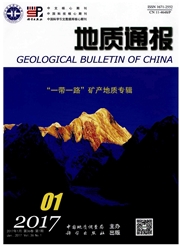

 中文摘要:
中文摘要:
阜平杂岩中的浅色体主要分为2种类型,早期浅色体基本沿片麻理分布,较富钾长石(微斜长石)、石英,贫斜长石,形成于低水深熔或压溶条件下,水含量较低,局部脱水但尚未达到整体脱水的程度;晚期浅色体切割现有的片麻理,较富斜长石、石英,贫钾长石,形成于有水熔融条件下,平阳奥长花岗岩的出现即与晚期浅色体相对应。南营片麻岩、南营浅色花岗片麻岩的地球化学性质与其他片麻岩具有明显的不一致性。浅色体的稀土元素配分型式较复杂,根据对元素相对富集或亏损的分析得知,大多数浅色体的形成受围岩成分的控制,从早期浅色体向晚期浅色体发展,稀土元素含量向LREE相对亏损、HREE相对富集的方向转化,某些微量元素有明显的继承性。与地球化学特征相比,矿物组合的确定对浅色体阶段的归属判定更为重要。阜平杂岩变质演化不是简单的进变质脱水反应,其水分含量的变化十分复杂,对其深入研究有助于更好地了解该区地质和构造的演化过程。
 英文摘要:
英文摘要:
The leucosomes in the quartzofeldspathic gneisses of Fuping Complex can be discerned to two types. The earlier type is rich in microcline, quartz, but poor in plagioclase and essentially aligned along the foliation. This leueosome is formed under lowwater anatexis or pressure solution, locally dehydrated but has not been up to the degree of total dehydration as a whole. Cutting the folition, the late type is rich in plagioclase, quartz, but poor in K-feldspar, and is derived from water-present partial melting. The Pingyang trondhjemite may correspond with this stage. But the Nanying gneiss and leucogranite are inconsistent with other gneisses of the region in geochemistry. The REE patterns of the leucosomes are very complicated. According to the relative enrichment or depletion of elements, we can deduce that most leucosomes are controlled by the host bulk chemistry. From the earlier leucosome to the later one, the REE tend to be relatively depleted in LREE and enriched in HREE, and some trace elements may inherit the features of the host. Relative to the geochemical features, it seems that the mineral assemblages of the leucosomes are more important for the stage ascription. The metamorphism evolution of the Fuping Complex is not simple progressive dehydration and the water content variation in the system is rather complicated. Detailed research can assist in elucidating the geological process of the region.
 同期刊论文项目
同期刊论文项目
 同项目期刊论文
同项目期刊论文
 期刊信息
期刊信息
